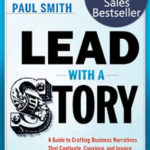 Today’s article is the third in a series learning from the book by Paul Smith, Lead With A Story: A Guide to Crafting Business Narratives that Captivate, Convince, and Inspire.
Today’s article is the third in a series learning from the book by Paul Smith, Lead With A Story: A Guide to Crafting Business Narratives that Captivate, Convince, and Inspire.
In chapter two, titled “Set a Vision for the Future,” Smith recounts a modified version of the well-known folktale of a woman asking three different construction-site workers what they are doing.
The first worker responds rather brusquely, “Can’t you see? I’m laying bricks!” The second worker is more polite, explaining, “I’m building a brick wall 30 feet tall, 100 feet wide, and 18 inches thick.” Unlike the first two, the third worker responds with excitement and says, “Oh, let me tell you! I am building the greatest cathedral the world has ever known!”
As Smith explains, the moral of the story is that if workers understand the overall objectives of their organization and how their individual work fits into those overall objectives, it not only helps them do a better job, it also enables them to help coworkers do a better job. This understanding also helps workers enjoy what they do because they understand how what they do fits into and supports the overall objectives of the organization. In other words, they understand the importance of what they do in the context of overall objectives.
As a leader in your healthcare organization, here is the crucial question:
Are those whom you lead laying bricks, building a wall, or building a cathedral?
Are those whom you lead in your healthcare organization merely sticking people with needles, passing out meds, cleaning the floors and keeping the environment clean? Or, are the people you lead clearly and enthusiastically focused on one of the greatest callings and contributions in the world? That would be achieving and maintaining healthier people and healthier communities. Healthy people and healthy communities contribute to a more healthy and prosperous environment for all of us.
Healthcare workers serve at the very highest level of priority and importance. As a healthcare leader, are you telling meaningful and effective stories in order to continuously inspire your team to focus on their high calling and the crucial importance of their service to individuals, communities, and society as a whole?
Don’t underestimate the power of storytelling. Use meaningful and effective stories to help those whom you lead connect with the overall objectives of your healthcare organization. As the chapter title suggests, use stories to “set a vision for the future.”
Copyright © 2013 by Dan Nielsen – www.dannielsen.com
National Institute for Healthcare Leadership – www.nihcl.com
America’s Healthcare Leaders – www.americashealthcareleaders.com

Be the first to comment on "Leaders: Use Stories to Set a Vision for the Future"